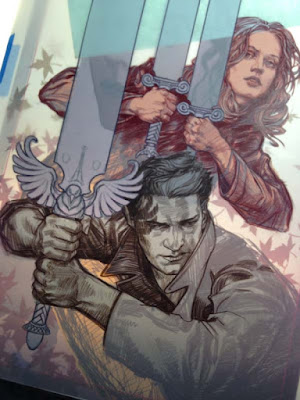'Business in the front and party in the back.' Dura-lar, aka, the Mullet of painting surfaces.
I first stepped into working on Dura-lar on a journey for the above. I wanted a surface that I could do detail work on the front side, but also be able to cut loose, get aggressive with my mark making on the reverse, and NOT mess up all the hard work I'd already done.
I tried vellum, or the modern version of vellum that comes in a pad (like a thick tracing paper). But it wrinkled when wet. Which can have some cool effects, but not what I was after. I do Yupo once in a while, but almost all the work has to happen on the front, because it isn't nearly as translucent.
Then I discovered the Grafix Dura-lar. It does not wrinkle no matter how wet you get it. And it has taken everything I have thrown at it from graphite to oil paint, like a champ.
The first thing to know is I use the MATTE version. Not the 'wet media' version. The matte will take dry media (Prisma, graphite, charcoal, pastel.) and wet media (Acrylic ink, acrylagouache, enamel, oil paint).
Because the matte is translucent, and not clear, it will ghost out what ever work is done on the reverse. I love this aspect because it is automatic atmospheric perspective, and lets you judge your final, darkest accents on the front.
What follows is a step by step of my Angel and Faith cover #19 for Dark Horse Comics. I am using Prisma Color pencil FW ink and Acrylagouache:
This is the level I took my digital comp before even beginning to make
it real. I like to have most of the design questions answered, which
frees me in the application of materials, because I can have fun with
such a solid foundation beneath me.
The rough drawing is printed out and is now on my light box with the
Dura-lar over the print. I have selected pencils within in a limited
range of values.
Time to DRAW! I did most of the first character with one prisma pencil.
Note how FLAT prisma color goes down on duralar. It is almost like
gouache!
I work my way through the second character in darker Prisma values than
the first. I am basically working in color zones through out the piece.
Having finished the characters, I move on to the swords and the falling leaves.
Detail shots.
For the third character I wanted a softer feel, so I used the side of the pencil for shading.
And here we have the drawing on dura-lar with a piece of white paper
behind it. Any values you saw prior to this were the original print-out
of my rough drawing.
I flip the drawing over and start working the back side. I mix a quick
gradient of Acrylagouache on my pallet, and start filling in the
transition of the leaves.
And when we flip it back over to the front, you can see the line-work
over the leaves. Some ask, "Why not just do it all on the front?" And
the reason is, it would be much harder to draw with colored pencil on
top of lumpy paint. And I want the lines to show, for as I get older I
realize the true heart of an artist is in the drawing. (No matter how
you frost it.)
Filling in the swords on the back, and the flip reveal.
The below sequence shows the puddle of value I mix for Angel, and the
ham fisted 'render' I do on the back side of figures. So there will be
some transition in the flat, some base structure, but the detail is all
on the front.
Same thing for Faith, filling in her form on the reverse with a painted gradient and crude modeling.
Ahh... but the magic is in the FLIP! The drawing is doing all the work!
With my dark and middle values established, it is time to work up the
highlights! Again using a range of three lighter value prisma pencils.
And here is the entire scene with the major elements drawn on front and painted on back. Now it is time to have fun!
This is where the really aggressive things happen. Spatter, streaks,
scratches it is all fair game because I know the major details of the
piece will be pristine on the front.
Flipping back over for more fun. You often have to paint in reverse, like an animation cel painter or a glass painter. Protecting things like figures with flat paint before you start up the party wagon of texture.
And the final flip! Sometimes I will cover the entire back with white after it is done.
Hope you enjoyed it!
















































0 comments:
Post a Comment